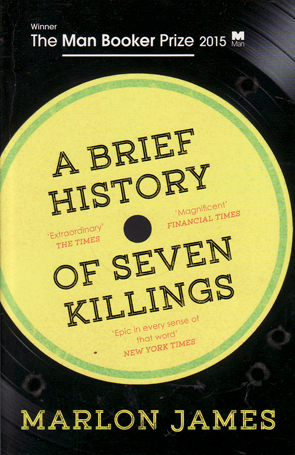On 8 December 1980, John Lennon was shot and killed by Mark David Chapman at the entrance of his residence in New York. This fact is briefly acknowledged by Dorcas Palmer, a character in Marlon James’ A Brief History of Seven Killings, almost 450 pages into the novel. Dorcas has nothing to say about it except as a point of personal reference, but given the subject of James’ novel, the attempted assassination of Bob Marley, the irony can hardly be lost: two music stars who advocated peace who suffered violent attacks.
The first thing you will recognise if you pick up a copy of Marlon James’ A Brief History of Seven Killings is that its title is a misnomer. At almost seven hundred closely-typed pages, it is hardly a brief book. So, this is something you have to consider if you are thinking of tackling it. It sat on my shelf for almost a decade because its length and the size of its typeface were intimidating. Not only is it long, but if you are unfamiliar with Jamaica’s political history you will need to familiarise yourself with its fundamentals as you read the opening chapters of the novel. It is also a polyphonic story. James successfully captures the voice and perspective of almost a dozen different narrators. Some chapters are written in a Jamaican ghetto patois of their character’s speech. And a final thing: the title is a misnomer not only for its promise of length, but even for the number of killings. I’ll get back to this point.
So far, I’m probably not selling this book to you. Everything sounds a little negative. But while A Brief History of Seven Killings may take some effort – an amount of concentration and commitment – it is an amazing novel that draws the dedicated reader into an unfamiliar world and a moment in history. It brings that world to life with rich detail and believable characters, many of whom are based on real people, and immerses its reader in a story of intrigue, violence, and the personal hopes and dreams, as well as the plans and machinations of its various protagonists. It is also an expansive book. For scope and ambition, the only comparison that comes readily to my mind is Don DeLillo’s Underworld: its length; that level of complexity; its attempt to paint society and its historical moment on a broad canvas through the brush strokes of individual stories. If this is also not selling the book to you – big and complex, my brain hurts! – then reviewers have also made comparisons with the films of Quentin Tarantino; I guess for the way Tarantino sets up his story, his storytelling style and yes, the inevitable violence. While there is an effort to be made by the reader, there is a payoff in the quality of the story and the big moments which supermarket fiction is unlikely to give you.
That’s my pitch. If you’ve come this far, you probably want to know something more about the story . . .
The central event in a A Brief History of Seven Killings might have predated John Lennon’s murder by four years, if only for an element of luck. Marlon James structures his novel around the attempted assassination of reggae singer Bob Marley in December 1976. To be clear, Marley is never identified by name throughout the novel. He is known only as the Singer. The novel begins a couple of days before the Singer is due to perform at the Smile Jamaica Concert. The concert had been arranged in response to the heightened level of political violence from a polarised society during 1976. On one hand there was the supporters of the People's National Party (PNP) of Prime Minister Michael Manley, and the pro-US opposition Jamaica Labour Party (JLP). A state of emergency had been declared in June 1976. Marley believed a concert would help quell the unrest and he arranged with with Michael Manley’s government through the Minister for Culture, Erskine Kingston, for a concert to take place on 5 December. This level of collaboration was necessary bureaucracy, not political collusion, but Marley nevertheless received criticism for aligning himself with the PNP government. Unfortunately, the prime minister also tried to take credit for the concert. When he brought the general election forward to 15 December, presumably to benefit from the anticipated good will, things turned sour. Marley had already been perceived as sympathetic to the PNP government despite his attempts to show neutrality, and the prime minister’s action only heightened the perception that the concert was political. Two days before the concert was to take place, gunmen entered Marley’s home with automatic weapons and shot him, his wife Rita, his manager Don Taylor, and a band employee while rehearsals were taking place. Somehow, no one was killed. Marley sustained wounds in his chest and arm. Despite this, he managed to make his appearance at the concert two days after the attack. He promised to sing a song, but he actually performed for ninety minutes with a bullet still lodged in his arm.
James bases his novel around this one incident. The official outcome of the attack was that no one died and no one was ever caught and brought to justice. But this is not the story that James tells. If you watch the video at the end of this review you will see that there was reputedly a level of retribution brought against the attackers. While Marley received criticism prior to the shooting, he was nevertheless a beloved and much revered icon in Jamaican culture. That retribution would follow, either to protect those behind the attack, or from those seeking justice in Marley’s name, was inevitable. The video recounts a ghetto trial held for three of the attackers by members of Claude Massop’s gang, a JLP sympathiser, as detailed in Don Taylor’s book Marley and Me. James dramatizes this scene almost dead-centre in his novel. The Singer is present, as he is in Taylor’s account. He is given an opportunity to pass judgement on the men by Don-Lo, Massop’s fictional surrogate. The Singer declines through his manager – in fact he doesn’t speak in the novel – but as detailed in Taylor’s account, the three men are executed: the first is shot and the last two are hanged.
So, there you have it. One, two, three killings already accounted for. But ticking off the seven killings isn’t what the book is about, even though attempting to do that while reading bears some interesting results. Actually, there are many killings, but let’s not get into that. Let’s deal with the detail of the seven killings before discussing the novel further.
If you were to make yourself a checklist of seven killings the place to start is the lineup of those who entered Marley’s house, as outlined early in the book. Josey Wales (yes, the character is really named after an American outlaw, although his real-life inspiration was probably a guy called Lester Coke) gathers a bunch of young men from the ghetto and sequesters them while they are trained by a CIA operative, Louis Johnson. In Don Taylor’s real-life account, he says that one of the men executed by Massop’s gang claimed the CIA had commissioned the attack in payment for cocaine and guns. If this seems far-fetched, consider the lengths the CIA went to, to take out Castro in Cuba during the 1960s. With Cuba just north of Jamaica, it seems reasonable that the American government would have had an interest in undermining the PNP, which had ties to the Workers Party of Jamaica, was sympathetic with Cuba and was deemed to have communist interests. The thought of two communist regimes just south of Miami would have been anathema to American interests.
So, the checklist: we begin with Josey Wales, who is initially Papa-Lo’s chief enforcer and a supporter on the PNP. But he slowly realigns with the interests of the JLP after he received multiple gunshots wounds in Balaclava during the State of Emergency in 1966. He barely survived and Wales develops a level of contempt for the Singer whom he believes lives an easy life while publicly dismissing the importance of his fame and wealth. He also sees that Papa-Lo is weakening – a yesterday man – who is financially propped up by the Singer. So, when Wales is approached by Louis Johnson of the CIA to make the hit on the Singer Wales is motivated to change allegiance and lead the raid on the Singer’s house. At his command is Bam-Bam, Weeper, Heckle, Renton, Matic, Funky Chicken, two men from the jungle and Demus. That makes ten. Matic dies preparing drugs incorrectly. Down to nine. Weeper shoots Renton because he expresses sympathies with Marley, but that death doesn’t count: the attack hasn’t happened yet. We’re down to eight. But by the end of his chapter Demus tells us they now have seven men. Never mind, Marlon James is not an accountant and your checklist will be left confused, anyway. Some minor spoilers here. Bam-Bam is killed (buried alive), Demus is shot, four other unnamed men are executed, but Heckle is eventually forgiven by the Singer who protects and mentors him (he later disappears but there is an implication he is not dead). Another young man, Leggo Beast, who has hidden in his mother’s cupboard for two years to escape retribution (perhaps he was one of the two unnamed to begin with) is executed too. Weeper also eventually cops it.
If this is not confusing enough for pedants like myself, trying to tally the numbers, it appears that the title of the novel isn’t even referencing these killings. Alex Pierce, a journalist who is sent to Jamaica to cover the Smile Jamaica Concert, crashes his own career so that he might be free to follow the bigger story of the Singer, Jamaican politics, and the temporary peace accord that later develops between rival gangs in Jamaica while gang dons Papa-Lo and Shotta Sheriff reside in jail together (their incarcerations are unrelated to the shooting). Pierce’s curiosity brings him to the attention of Josey Wales who perceives that he might be a threat, given what he uncovers. Pierce’s near-death encounter with Wales’ hitman eventually exposes his work to a New York Jamaican gang leader who wants to control the story Pierce is publishing. The story is called ‘A Brief History of Seven Killings’. Pierce’s story is about a crack house in New York which had been shot up by Josey Wales in a fit of rage. Eubie, the leader of the New York posse asks, “What me want to know though, in part one [of the story] you say is eleven people get kill. So how come you only write ’bout seven?” Pierce is forced to admit, “Couldn’t find any info on the other four. Besides, seven is a good round number.” If you go back to the incident that they’re discussing you can count off ten victims. The eleventh is an unborn child carried by Monifah, a young woman trying to break her drug addiction who is shot in the head by Josey Wales.
Eubie is incensed at Pierce’s emotive dramatization of the story: “Cut our enemies and innocent bystanders down in a hailstorm of bullets. Anybody here look like the people who would use word like hailstorm? What the fuck wrong with you?” Pierce is perceptive enough to understand the import of what he is writing, but his approach reflects difficulties Marlon James admits to in his Acknowledgements as he initially tried to shape his own narrative: “Draft after draft, page after page, character after character, and still no through line, no narrative spine, nothing.” James has Pierce express a similar frustration: “My story needs a narrative line. It needs a hero, a villain, and a Cassandra.” Pierce is used to understanding situations through narrative, and he takes Norman Mailer as his model. Mailer, along with other writers like Hunter Thompson (whom Pierce despises) were practitioners of New Journalism in the 1960s. New Journalism pushed the bounds of traditional journalism by including literary techniques normally held to be the purview of fiction. In Miami and the Siege of Chicago, Pierce tells us, Norman Mailer went a step further by inserting himself into the narrative. He posed as part of a security detail to gain access to a banquet as a part of his coverage of the Republican campaign in 1968. As James’ novel progresses, Pierce becomes more and more a participant in the story rather than merely an observer.
Eubie offers Pierce advice as he sifts through his story:
Well, at some point you gotta expand on a story. You can’t just give it focus, you gotta give it scope. Shit doesn’t just happen in a void, there’re ripples and consequences and even with all that there’s still a whole fucking world going on, whether you’re doing something or not. Or else it’s just a report of some shit that happened somewhere and you can get that from nightly news, I mean, while Monifah was getting shot because of one crack hit, somebody just bought a crack vial from somebody, who got it from somebody, whose supply came from somebody.
It’s as though James is working out the challenges he faces writing his own narrative through the voice of Eubie; calling for a more expansive and nuanced story, which reflects what James finally achieves. As for Pierce, he is possibly another character based on real life in this roman à clef, although possibly not from the period in which the story takes place. James was partly inspired to write his novel after reading an article by Mattathias Schwartz, ‘A Massacre in Jamaica’, in 2011. The Obama government had called for the extradition of Christopher Coke, the don controlling Tivoli Gardens, the area of Kingston represented as Copenhagen City in James’ novel. Schwartz’s article is an account of the violent attempt to extract Coke from Tivoli Gardens which resulted in the deaths of numerous residents as they fought to hold off the police. Coke escaped but was caught a month later and extradited. Christopher Coke was the youngest son of Lester Coke, the don leading the violent drug gang, the Shower Posse at the end of the 70s and into the 80s, who is the inspiration for James’ Josey Wales. Schwartz acknowledges this context in his article, which is written in a New Journalist style that brings the saga to life.
And this is what James achieves, too. There is so much history, politics and social context to convey about this period that it would have been easy for a lesser writer than Marlon James to have written a “report of some shit that happened somewhere”. James pulls the disparate story together, stretching over decades, through the use of his polyphonic narrative. Again, in his Acknowledgements, he expresses his indebtedness to a rereading of Faulkner’s As I Lay Dying and Marguerite Duras’ The North China Lover as inspirations to overcome his narrative difficulties. Part of the difficulty James’ narrative faced is that the central event of his narrative is focussed on the Singer who dies in 1981. But James projects his narrative beyond this, giving the shooting and the political events of 1976 a broader context, but making a “narrative spine” harder to achieve. Instead, James tells many stories stemming from his first event, like spokes on a wheel, separate but circling its hub. So, characters like Bam-Bam and Demus are limited and can only take us so far, but they give us insight into the group that attack the Singer and the aftermath of the event. Barry Diflorio, the CIA station chief in Jamaica is too immured in his failing marriage and dealing with a security leak to be properly over the events leading to the shooting. But this is life and Diflorio’s story gives a human face to an otherwise monolithic organisation. Papa-Lo is a harsh don of Copenhagen City, but his respect for the Singer and a certain naivety in his belief of how things will progress is belied by his growing realisation that he is being sidelined by Josey Wales. Papa-Lo’s attempts to exert justice and his eventual betrayal expresses a feeling that Jamaica is changing in bewildering ways that will usher in a harsher and more violent period, guided by the likes of Josey Wales.
But the skill of James’ novel is that he is able to draw seemingly disparate stories into one. This is nowhere better exemplified than in the character of Nina Burgess, whose story spans the many decades of the novel. Nina is a witness to the shooting at the Singer’s house because she is waiting outside to see him, day after day. Nina has been cast aside after she falls pregnant to the Singer, and her big hope lies in extracting enough money from him that she might get herself and her parents out of Jamaica to the United States. Nina’s personal trajectory represents the trajectory of the plot as it moves into the streets of New York in the latter part of the novel. But she also represents ordinary Jamaicans who just want a better life, free of politics and violence. Her numerous identities and her ability to reinvent herself are a testament to this desire, her intelligence and fortitude. The fact that she is willing to take care of a dementia patient whom she is incorrectly assigned by her agency says a lot about her: Ken cannot remember her from day to day. She is a woman who wishes to leave the past behind. Nina stands in contrast to Alex Pierce, an American who has no real skin in the game in Jamaica, but has fetishised the country’s violence, beginning with the Singer’s shooting, believing he can monetise the story. Decades later, he still cannot leave it alone.
All this speaks to why James’ novel is so skilful and immersive. But it is an important novel not only for the breadth of its representation, but also its insight. Tristan Phillips, an inmate in Rikers Prison, has a moment of insight as he speaks to Pierce about the background for his story:
People need to know. They need to know I guess that, that there was this one time when we could’a do it, you know? We could’a really do it. People was just hopeful enough and tired enough and fed up enough and dreaming enough that something could’a really happen.
Phillips’ tone is nostalgic, but it is also regretful. The events Pierce is attempting to write about are newsworthy, but they also represent an historical moment of lost opportunity. Now, instead of pride, Jamaica has been rocked by violence and the drug trade:
Now is shit for so long that people grow up in shit thinking shit is all they is. But people need to know that. Maybe that too big for you. Maybe that too big for one book …
Perhaps this is a depressing thought. But it is an insight James is willing to accommodate in his story. By the time James read Scwartz’s article in 2011, circumstances hadn’t changed much. Lester Coke was gone but his son had been in charge of Tivoli Gardens since the 90s, and Jamaica’s political and social situation had remained pretty much the same since Jamaica gained independence in 1962. Its people were still divided over the two political parties, and which each side still accused the other of being manipulated by foreign players against the interests of Jamaica. Internecine political violence remained a problem. And Kingston was still largely run by gangs funded by the drug trade. The level of dependence on the gangs is exemplified by the fact that residents at Tivoli Gardens were willing to defend Coke. Several died doing so. Apart from the gang violence, the ghettos suffered violence from its own police force in the form of extrajudicial killings. Schwartz is critical of the police tactics in the raid, as is James in the broader scope of his novel. Like his real-life model, Claude Massop, Papa-Lo is stopped by police with a road block and summarily executed.
Even so, there is some level of hope, no matter how dim. James also allows that someone like Nina might escape, albeit at great personal cost: at the loss of identity, family and her sense of security. It is a small ray of hope in a novel that understands that the basic facts of history – seven killings or more – are less important than a broader understanding of a society and the context of its history.

 RSS Feed
RSS Feed Facebook
Facebook Instagram
Instagram YouTube
YouTube Subscribe to our Newsletter
Subscribe to our Newsletter










No one has commented yet. Be the first!